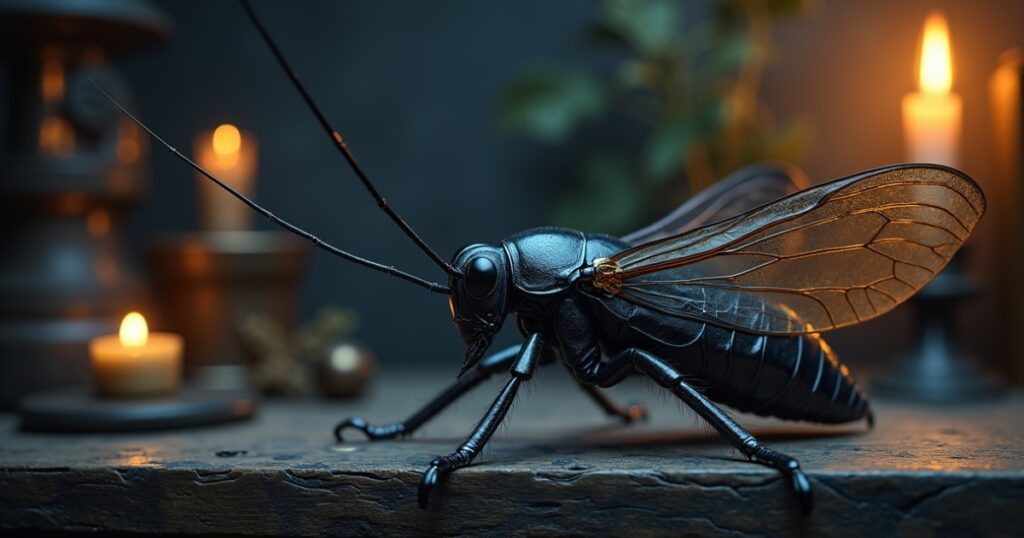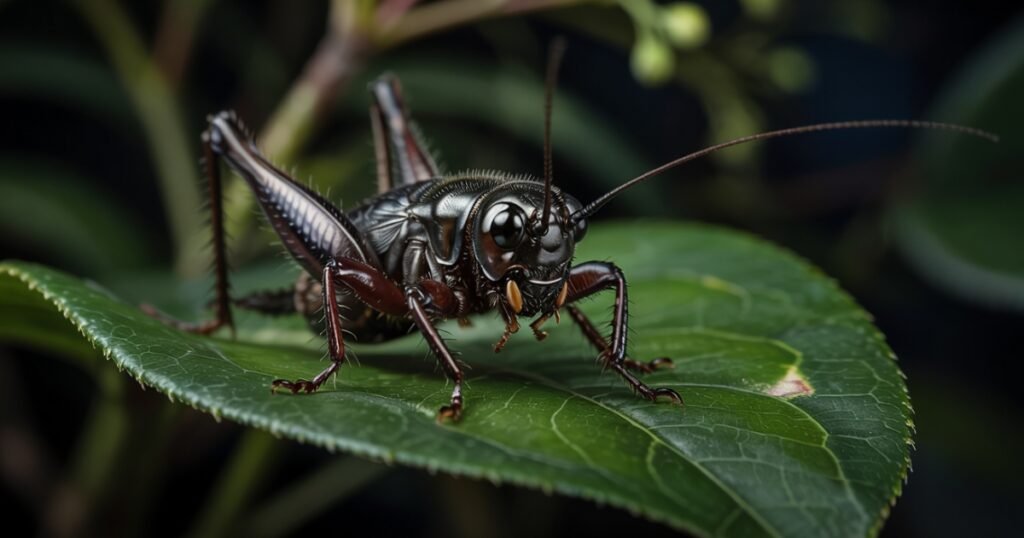Have you ever been startled by the sudden chirping of a black cricket in your home? Or perhaps you’ve spotted one of these glossy visitors scurrying across your kitchen floor. For centuries, finding a black cricket in your house has sparked curiosity and sometimes concern. Is it just an insect seeking shelter, or does it carry deeper meaning?
In this comprehensive guide, we’ll explore the fascinating intersection of science and symbolism surrounding these common household visitors.
From ancient folklore to modern entomology, we’ll uncover what it really means when a black cricket crosses your threshold and whether you should welcome it or show it the door.
The Science Behind Black Crickets in Your Home
Before diving into symbolism, let’s understand the actual creatures we’re discussing. The black cricket in house phenomenon is usually one of several species, most commonly the field cricket (Gryllus species) in North America and Europe.
Common House Cricket Species
| Cricket Type | Scientific Name | Appearance | Typical Behavior |
|---|---|---|---|
| Field Cricket | Gryllus species | Shiny black body, 1/2 to 1 inch long | Nocturnal, prefers warm, moist environments |
| House Cricket | Acheta domesticus | Yellowish-brown with three dark bands | Adapted to indoor living, constant chirper |
| Jerusalem Cricket | Stenopelmatus species | Large, up to 2 inches, amber with black stripes | Silent, primarily outdoor dwellers |
| Camel Cricket | Rhaphidophoridae family | Light brown, humpbacked appearance | Non-chirping, jumps when startled |
Black field crickets typically enter homes for simple reasons:
- Temperature seeking: As weather cools, they look for warm shelter
- Moisture requirements: They need humid environments to survive
- Food sources: Fabric, paper, and food debris attract them
- Light attraction: Outdoor lighting draws them toward homes
Dr. Maya Patel, entomologist at Northwestern University, explains: “Cricket home invasions are purely survival-driven. They’re not plotting or delivering messages they’re simply following environmental cues that lead them indoors, especially as seasons change.”
Their distinctive chirping produced only by males rubbing their wings together serves to attract mates and establish territory.
The louder and more persistent the chirp, the more desperate the cricket is to find a partner before its relatively short life cycle ends.
Historical Cricket Symbolism: Origins and Evolution
The practice of attributing meaning to crickets dates back thousands of years. The spiritual meaning of a black cricket in your house varies dramatically across cultures, but some common threads emerge.
Ancient Chinese Cricket Traditions
In China, crickets have been revered for over 2,000 years. During the Tang Dynasty (618-907 CE), people began keeping crickets in special cages for their songs. By the Song Dynasty, cricket fighting became popular entertainment with black crickets particularly prized for their fighting spirit.
The Chinese character for cricket (蟋蟀) appears in the oldest Chinese dictionary, indicating their cultural importance.
Crickets represented courage, fighting spirit, and good fortune. A cricket entering the home was seen as bringing luck and prosperity.
European Hearth Cricket Beliefs
In European folklore, the “hearth cricket” gained spiritual significance as protector of the home. In Charles Dickens’ “The Cricket on the Hearth” (1845), he writes:
“To have a cricket on the hearth is the luckiest thing in all the world!”
This sentiment echoed folk beliefs that crickets brought good fortune and protection to families. Unlike other insects that might damage crops or spread disease, crickets were largely harmless visitors who provided cheerful music.
Their presence near the hearth the literal and metaphorical heart of the home made them symbols of domestic harmony.
Native American Perspectives
Many indigenous North American tribes viewed crickets as messengers or bearers of wisdom. The Hopi considered crickets sacred and associated them with rain crucial for agricultural success.
For some tribes, cricket songs were believed to predict weather changes or even warn of danger.
Positive Cricket Symbolism Examined
Many cultures associate black cricket spiritual meaning with positive outcomes or messages. These interpretations often connect to observable cricket behaviors.
Good Fortune and Prosperity
The association between crickets and good fortune stems from several observations:
- Agricultural timing: Cricket activity often coincided with harvest times
- Home protection: Crickets eat smaller pest insects
- Weather prediction: Their activity levels change with barometric pressure
- Resilience: Their ability to thrive in various environments
In many Asian cultures, keeping cricket figurines particularly gold ones symbolizes wealth. Chinese feng shui practitioners sometimes recommend placing cricket imagery in the wealth corner of the home to attract prosperity.

Guardian of the Hearth
The black cricket in house meaning often connects to protection and vigilance. Consider these aspects of cricket behavior that reinforced this symbolism:
- They remain alert at night when humans sleep
- Their sudden silence often indicates approaching danger
- They establish territory and defend it
- They typically avoid human contact unless feeling secure
This protective symbolism translated into the belief that a cricket watching over the family provided spiritual security. Some European traditions warned against killing household crickets, believing this would remove protection from the home.
Creativity and Artistic Expression
The cricket’s distinctive song has linked it to music, poetry, and creativity across cultures:
- In Native American folklore, crickets taught the first songs
- Japanese poetry features crickets as symbols of musical talent
- European fairy tales depict crickets as master musicians
- Chinese cricket cages were often artistic masterpieces themselves
For creative individuals, finding a black cricket in your house might be interpreted as encouragement for artistic pursuits or a reminder to express one’s unique voice.
Negative Cricket Symbolism Examined
Not all cricket associations are positive. Some cultures developed more ominous interpretations of cricket encounters.
Death Omens and Misfortune
In parts of southern Europe and Latin America, black crickets specifically were sometimes associated with death or approaching hardship. These beliefs likely developed from:
- The sudden appearance of crickets before seasonal changes
- Their nocturnal nature and dark coloration
- The somewhat eerie quality of their persistent chirping
- Their occasional population explosions causing crop damage
In some traditions, a cricket’s sudden silence was considered particularly ominous, potentially predicting a death in the family.
Psychological Effects of Cricket Sounds
The incessant chirping of crickets can trigger various psychological responses:
- Disrupted sleep: Leading to stress and irritability
- Heightened awareness: Creating anxiety or vigilance
- Sound sensitivity: Causing discomfort for those with sensory issues
- Anticipatory anxiety: Wondering when the next chirp will come
These effects might explain why some cultures developed negative associations. When experienced night after night, even pleasant natural sounds can become psychological stressors.
See Also: When a Roadrunner Crosses Your Path: Ancient Wisdom & Modern Encounters
The Black Cricket Specifically: Special Meanings?
While many cricket symbolisms apply to all species, black cricket meaning sometimes carries distinct significance.
Color Symbolism Across Traditions
Black has specific symbolic associations in many spiritual traditions:
- Protection: Black absorbs negative energy in many metaphysical systems
- Mystery: Representing the unknown or hidden knowledge
- Transformation: Symbolizing potential for change and growth
- Authority: Conveying power and strength
The combination of cricket symbolism with these color associations creates unique interpretations. For example, in some metaphysical traditions, a black cricket might represent protected transformation or powerful messages from the subconscious.
Scientific Reality of Black Crickets
From a biological perspective, black crickets differ from their brown cousins in several ways:
- Temperature regulation: Darker exoskeletons absorb more heat
- Predator visibility: More visible to predators in daylight
- Species differences: Different behaviors and preferred habitats
- Maturity indicator: Some crickets darken with age
These differences might contribute to why black crickets trigger stronger symbolic responses. Their more dramatic appearance and potentially different behaviors make them more noticeable and memorable house guests.
Practical Guidance for Cricket Encounters
For those less interested in symbolism and more concerned with cricket management, here’s practical advice.
Humane Removal Techniques
If you prefer to remove crickets without harm:
- Capture and release:
- Place a jar over the cricket
- Slide paper underneath
- Release outdoors in a sheltered area
- Cricket-friendly traps:
- Place a paper towel tube with one end closed on the floor
- Put a small piece of fruit inside
- Check daily and release captured crickets
- Light guidance:
- Darken the room except for one exit path
- Use a flashlight to guide the cricket toward the exit
Preventing Future Cricket Visits
To reduce the likelihood of cricket visitors:
- Seal entry points around doors, windows, and foundations
- Reduce outdoor lighting that attracts insects
- Maintain dry perimeters around your home
- Remove yard debris where crickets might gather
- Use weather stripping under doors
Environmental consultant Jordan Reed notes: “The most effective cricket prevention is simply removing what attracts them moisture, shelter, and easy access. No repellent works as well as good home maintenance.”
The Psychology Behind Cricket Symbolism
Our tendency to find meaning in cricket encounters reveals interesting aspects of human psychology.

Pattern Recognition and Meaning-Making
Humans are natural pattern-seekers and meaning-makers. When unusual events occur like finding a distinctive insect indoors our brains automatically search for significance. This tendency served evolutionary purposes:
- Threat detection: Identifying potential dangers
- Resource location: Recognizing beneficial patterns
- Social cohesion: Sharing meaningful experiences
- Knowledge transfer: Creating teachable moments
Psychologist Dr. Amina Ibrahim explains: “Finding meaning in natural events like cricket appearances gives people a sense of control and understanding in an unpredictable world. Whether scientifically accurate or not, these meaning systems provide psychological comfort.”
Confirmation Bias and Cricket Encounters
Once we learn about cricket symbolism, confirmation bias affects how we interpret encounters:
- We notice “lucky” events after seeing crickets if we believe they bring good fortune
- We attribute misfortunes to cricket sightings if we believe they’re bad omens
- We pay more attention to crickets that match our expectations
- We remember encounters that confirmed our beliefs more vividly
This psychological tendency reinforces cultural beliefs across generations, regardless of evidence.
Cricket Feng Shui: Intentional Use of Cricket Symbolism
For those who find value in cricket symbolism, intentional incorporation into living spaces offers a way to embrace these traditions.
Cricket Imagery in Home Design
Contemporary designers sometimes incorporate cricket motifs:
- Wallpaper patterns featuring stylized crickets
- Decorative objects like brass cricket figures
- Textile designs with cricket imagery
- Garden sculptures celebrating these insects
Interior designer Lucia Chen comments: “Cricket motifs add whimsy while connecting to ancient traditions of good fortune. They’re particularly popular in spaces dedicated to creativity or prosperity, like home offices or entryways.”
See Also: What Does It Mean When a Bird Hits Your Window and Flies Away: Spiritual & Scientific Perspectives
Placement Principles
Those following feng shui principles might place cricket imagery:
- In the wealth corner (southeast) to attract prosperity
- Near the hearth or kitchen for family protection
- In creative spaces to stimulate artistic expression
- By entryways to welcome good fortune
Cultural Case Studies: Cricket Symbolism Worldwide
Chinese Cricket Culture: From Fighting to Fortune
In China, cricket appreciation evolved into a sophisticated cultural practice. During the Ming and Qing dynasties, cricket fighting became so popular that specialized markets emerged selling the most promising fighters with black crickets often commanding the highest prices.

Special cricket cages made from gourds, bamboo, or precious materials became prized possessions. The most elaborate featured intricate carvings, jade embellishments, and tiny furniture for the cricket’s comfort.
Beyond entertainment, the Chinese appreciation for crickets stemmed from their perceived virtues:
- Courage in the fighting arena
- Musical talent in their distinctive songs
- Sensitivity to environmental changes
- Resilience through seasonal challenges
These virtues transformed crickets from mere insects into embodiments of admirable qualities. Finding a cricket in your home became a sign that these virtues might bless your household.
Mediterranean Traditions: The Hearth Cricket as Family Guardian
In Mediterranean countries like Italy, Greece, and Spain, black crickets found indoors were often considered protective spirits. Families sometimes left small offerings a drop of wine or crumb of bread for household crickets.
These traditions likely originated from practical observations:
- Crickets consume smaller household pests
- Their presence indicates a dry, warm home
- Their sudden silence warns of approaching disturbances
- They cause minimal damage compared to other insects
Portuguese folklorist Maria Santos documented this tradition: “In rural villages, I found elderly residents who still maintained small cricket hotels tiny structures of stone or wood where crickets could shelter. They were positioned near the hearth as honored guests rather than unwelcome pests.”
Scientific Perspective on “Lucky Crickets”
From an ecological standpoint, crickets do provide certain benefits that could, metaphorically speaking, be considered “lucky” for homeowners.
Ecological Benefits of Cricket Presence
Crickets serve several positive ecological functions:
- Bio-indication: Their presence indicates environmental health
- Pest control: They consume smaller insects and plant debris
- Soil health: Their droppings add nutrients to soil
- Food chain support: They feed birds, reptiles, and other wildlife
Ecologist Dr. James Wilson explains: “While I wouldn’t call them lucky in a mystical sense, crickets generally indicate a balanced local ecosystem. Their presence often means your home isn’t contaminated with harmful pesticides or environmental toxins that would kill more sensitive insects.”
Environmental Health Indicators
The type and behavior of crickets can reveal information about your home environment:
| Cricket Behavior | Environmental Indication |
|---|---|
| Numerous crickets suddenly appearing | Weather change approaching |
| Crickets in bathrooms/basements | Excessive moisture issues |
| Louder than normal chirping | Temperature increase |
| Crickets dying indoors | Possible pesticide contamination |
| Seasonal cricket appearance | Natural migration patterns |
Making Peace with Cricket Visitors
Whether you embrace the spiritual meaning of a black cricket in your house or view them from a scientific perspective, finding middle ground helps us appreciate these fascinating creatures.
Mindful Approaches to Cricket Encounters
Consider these balanced perspectives when you next encounter a house cricket:
- Observe before reacting: Watch its behavior with curiosity
- Consider practical implications: Assess whether it’s causing actual problems
- Acknowledge cultural significance: Appreciate the rich history of human-cricket relations
- Make conscious choices: Decide whether to cohabitate or relocate based on your values
Environmental educator Robin Kaye suggests: “When people find crickets indoors, I encourage them to ask: Is this causing harm, or just surprise? Often our initial reaction to insects is disproportionate to any actual threat they pose.”
Finding Personal Meaning
Ultimately, the meaning of cricket encounters is deeply personal:
- Some find comfort in traditional interpretations
- Others appreciate the scientific wonder of these evolutionary survivors
- Many enjoy the simple pleasure of their musical contributions
- Some create their own meaningful interpretations based on personal experience
The most balanced approach acknowledges both the natural reality of crickets as living creatures and the rich cultural heritage they’ve inspired.
Conclusion: Myth or Fact?
So what does finding a black cricket in your house truly mean? The answer lies somewhere between scientific fact and cultural interpretation.
The facts: Black crickets enter homes seeking warmth, moisture, and food. Their behavior follows biological imperatives rather than mystical purposes. They generally cause minimal harm compared to truly destructive pests.
The cultural significance: For thousands of years, humans have found meaning in cricket encounters, creating rich traditions that enhance our connection to the natural world. These symbolic systems provide psychological comfort and cultural continuity.
Perhaps the true value lies in this intersection where scientific understanding and cultural meaning meet. A black cricket in your house can be simultaneously:
- An insect following evolutionary programming
- A reminder of our interconnection with nature
- A carrier of cultural wisdom across generations
- An opportunity for mindful observation of the world around us
Whether you welcome your cricket visitor as a lucky charm or gently return it to the outdoors, the encounter offers a moment to pause, observe, and connect with both natural wonder and human tradition.
FAQs
Why do crickets suddenly appear in my house?
Crickets typically enter homes when outdoor conditions become less favorable usually due to temperature drops, excessive rain, or drought. They’re seeking shelter, consistent temperature, and moisture. Entry points like gaps under doors, foundation cracks, or open windows provide easy access.
What’s the difference between black crickets and other species?
Black crickets are usually field crickets (Gryllus species), which have adapted to outdoor environments but come indoors for shelter. House crickets (Acheta domesticus) are typically lighter tan or brown and have adapted more specifically to human dwellings. Black crickets tend to be slightly larger and have stronger jumping abilities than their house cricket cousins.
Are crickets harmful to my home or health?
Crickets pose minimal health or structural risks. Occasionally, they may chew on paper, fabrics, or plants, but damage is usually minor compared to truly destructive pests. They don’t bite humans or spread disease. Their primary “nuisance” factor is the persistent chirping of males, which can disrupt sleep or concentration.
How can I remove crickets without killing them?
Use a cup or jar to trap the cricket, then slide paper underneath to create a temporary container. Release it outside in a sheltered area away from your home. Alternatively, create a simple trap using a paper towel tube with one end closed and baited with a piece of fruit or bread. Check it daily and release any captured crickets.
Do cricket populations indicate climate or environmental changes?
Yes, cricket populations and behaviors can indicate environmental shifts. Changes in cricket activity often precede weather changes, as they’re sensitive to barometric pressure and humidity.
Researchers have noted that climate change has altered cricket migration patterns, breeding seasons, and geographic distribution in recent decades.









